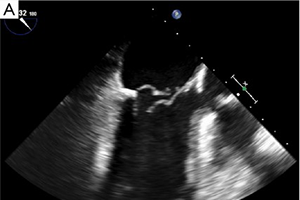Current state of transcatheter mitral valve repair with the MitraClip
Abstract
Background: Many patients affected with mitral valve regurgitation suffer from multiple comorbidities. The MitraClip device provides a safe means of transcatheter valve repair in patients with suitable mitral valve anatomy who are at prohibitive risk for surgery. We describe our early procedural outcomes and present a summary of the current state of MitraClip technology in the United States.
Methods: We performed a retrospective chart review of initial high-risk or inoperable patients who underwent MitraClip placement at our institution after completion of the EVEREST II study. We examined the primary outcome of 30-day mortality, and secondary outcomes included extent of reduction of mitral regurgitation (MR), New York Heart Association (NYHA) functional class improvement, length of stay, and major complications.
Results: A total of 115 high-risk patients (mean Society of Thoracic Surgeons predicted risk of mortality 9.4%±6.1%) underwent the MitraClip procedure at our institution between March 2009 and April 2014. Co-morbidities including coronary artery disease (67.8%), pulmonary disease (39.1%) and previous cardiac surgery (44.3%) were common. The device was placed successfully in all patients with a 30-day mortality of 2.6%. All patients demonstrated 3+ or 4+ MR on preoperative imaging, and 80.7% of patients had trace or 1+ MR at hospital discharge. NYHA class improved substantially, with 79% of patients exhibiting class III or IV symptoms pre-procedure and 81% reporting class I or II symptoms at one month follow-up.
Conclusions: The MitraClip procedure provides a safe alternative to surgical or medical management for high-risk patients with MR and suitable valve anatomy. A comprehensive heart team approach is essential, with surgeons providing critical assessment of patient suitability for surgery versus percutaneous therapy as well as performance of the valve procedure.
Cover






